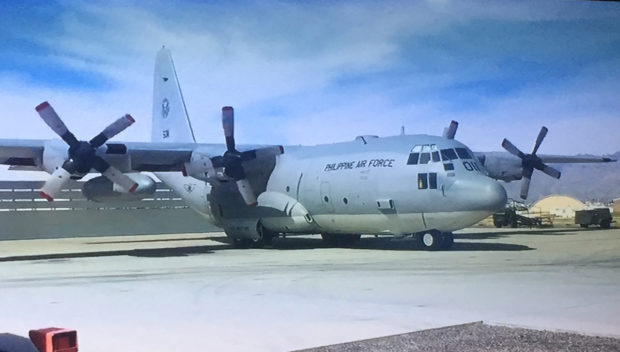The C-130 Hercules: Transport workhorse generally safe, according to USAF

Two C-130 secondhand transport planes from the United States are scheduled to be delivered this year– one next week and the other in September. The two assets will give a boost to the territorial defense and humanitarian assistance operations of the Philippine military. File photo from Philippine Air Force
MANILA, Philippines—The C-130 Hercules plane of the Philippine Air Force (PAF) had been used by the government to help in health missions during the pandemic.
The one that crashed in Patikul, Sulu had been in service for the PAF for five months since its delivery at the Villamor Air Base in Pasay City last Jan. 29.
Worth P1.54 billion, the tactical airlift from the United States (US) was acquired by the government through the Foreign Military Financing grant program “to strengthen the Philippine military’s logistical capacity for military and civil support operations.”
What is a C-130 Hercules plane?
The US Air Force (USAF) defined C-130 Hercules as an aircraft that “primarily performs the tactical portion of the airlift mission.”
“The aircraft is capable of operating from rough, dirt strips and is the prime transport for airdropping troops and equipment into hostile areas,” it said.
Article continues after this advertisementIt’s able to do so because it has what the US Air Force said was modified tricycle-type landing gear which allows operation from “rough, unimproved runways.”
Article continues after this advertisementThe C-130 brakes also work in such rough runway conditions because they are hydraulically operated and are multiple disc types, among other features.
The aircraft was designed to transport in combat areas through “airdrop or short runways”. The C-130 has been serving the US Air Force for more than 50 years already.
It performed a “wide range of operational missions in both peace and war situations”. These included airlift support, Antarctic resupply missions, medical missions, weather reconnaisance, aerial spraying, firefighting.
On its website, the US Air Force said that with “aft loading ramp and door,” the aircraft can carry oversized cargo and can “airdrop loads up to 42,000 pounds or use its high-flotation landing gear to land and deliver cargo on rough, dirt strips.”
“The flexible design of the Hercules enables it to be configured for many different missions, allowing one aircraft to perform the role of many,” the US Air Force said.
“Much of the special mission equipment added to the Hercules is removable, allowing the aircraft to return to its cargo delivery role if desired,” it said.
Is it safe?
In January 1998, the US Secretary of the Air Force asked the acting Chief of Staff of the US Air Force to conduct a broad area review (BAR) of the aircraft’s flight safety.
It came following the request of the US Senate and the what is known in the US as King 56 accident—the 1996 C-130 crash that killed 10 people.
The review looked into all C-130 aircraft systems with “specific emphasis on safety-related issues or deficiencies that exist.”
In its BAR, the team that was tasked by the Secretary of the Air Force said that it “came away from this review convinced that the C-130 has been and remains a very safe and dependable aircraft.”
The team noted that the aircraft’s synchrophaser (an electronic device used to synchronize the propellers and phase the passing of their blades as they turn so as to reduce propeller-induced noise and vibration), was to blame for King 56 and other engine power loss incidents.
“The BAR examined the C-130 fleet safety record and found that, in almost 25 million flight hours worldwide, there had not been a recorded instance before the King 56 accident where all four engines quit running in flight,” the report said.
The aircraft, the review stated, is “equipped with more precise navigation equipment, allowing lower altitudes during night operations. They are also capable of landings on unlit landing zones and aerial refueling in flight”
Its engine’s power section also has a single entry and is mounted with components of the engine fuel, ignition, and control systems.
TSB
